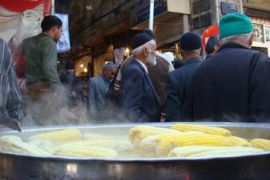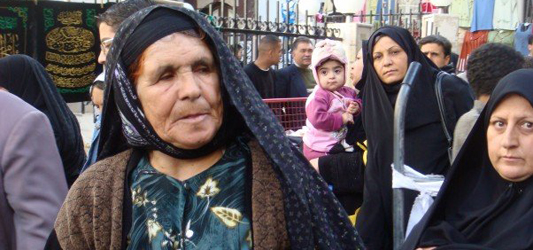Pilgrims’ progress
Bilateral ties flourish as Iranians flock to Shia shines in Syria in great numbers.

 |
| Iranian Shia pilgrims have been coming to Syria since the 1980s |
An estimated 8,000 Iranian Shia pilgrims pour into Syria every day, usually arriving in busloads into the capital, Damascus and their numbers are steadily growing.
Some of them travel for up to five days to arrive at Sit Ruqiya, one of Syria‘s holiest Shia shrines.
Crossing the border, these pilgrims bring their faith, their culture and their money.
| In video | ||
|
|
Speaking to Al Jazeera, Ahmed, a Syrian street trader, said: “The pilgrims started coming here in the 1980s. My business has improved. I learned Farsi, and the customers just keep on coming.”
In the past five years, Iran and other Shia communities around the world have pumped millions of dollars into the reconstruction of half a dozen Shia holy sites in Syria.
And Sit Ruqiya is one that has gone from humble beginnings to being one of the largest shrines in Damascus.
Sound economics
Many believe that this cultural crossover with the Iranians is fostering yet another symbiotic relationship and it is that of big business.
Al Jazeera visited the Sham Factory – a joint Syrian-Iranian project on the outskirts of Damascus and one of the first and biggest ventures yet.
Established in March this year, the factory aims to produce 40 cars per day off its assembly line, when the factory reaches full capacity, which it nearly has.
The final product is a Syrian car with a distinctly Iranian flavour.
On the ground, entrepreneurs are hoping the expanding markets will provide them with more business opportunities.
|
Obviously there is awareness in Iran and Syria that they need to do more especially because the two countries are relatively isolated” |
Sayyd Razi Vahedi is an Iranian businessman who works closely with his Syrian counterpart to make such opportunities happen.
“The trade and economic relationship between Syria and Iran is improving and we hope that this relationship will continue to grow stronger and stronger,” he told Al Jazeera.
Syria is hoping that Iran will pull it out of its decades-long recession – a situation seen by many as the reason behind many Syrians leaving the country.
UNDP says 15 million Syrians are living outside the country – a staggering number considering only 17 million people reside in Syria.
Strange allies
Bringing Syria and Iran together is the US-imposed isolation.
They are unlikely allies today with differing religions, economies and political ideologies, though some neighbours view the relationship with suspicion.
“Obviously there is awareness in Iran and Syria that they need to do more especially because the two countries are relatively isolated,” Jihad Yawing, an economic analyst, said.
“We are very happy with this relationship and we will expand it both politically and economically. That’s a fact of life in the Middle East today,” Abdullah Dardari, Syria‘s deputy minister for economic affairs, said.
“But to say that Iran is using Syria as a foray into the Arab region is putting too much politics into this economic relationship,” he told Al Jazeera.
All eyes remain fixed on Syria and Iran to see how far this long-standing courtship will go.
It is a highly charged subject for the region, but for both countries, at the moment, it seems to make perfect business sense.
The question now is whether economics preserve this political relationship in the face of increasing international pressure.
